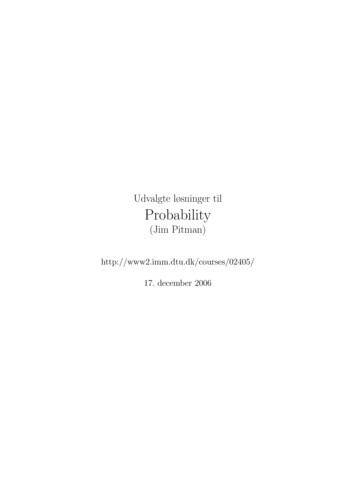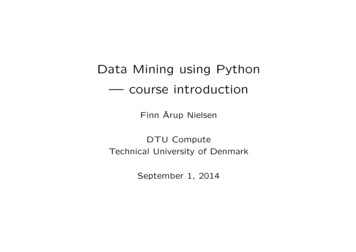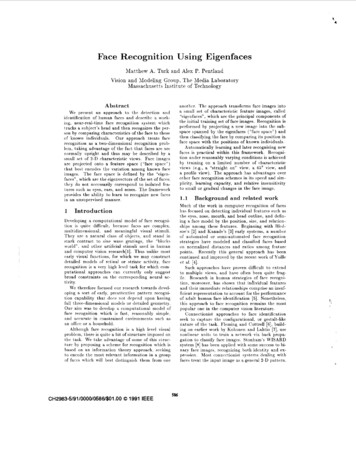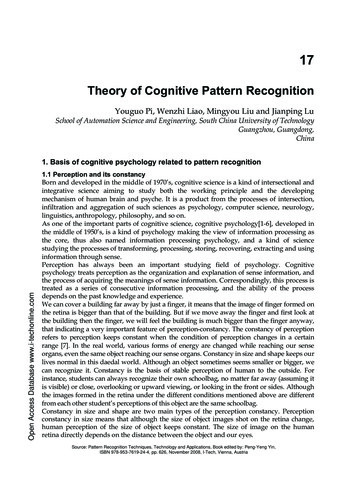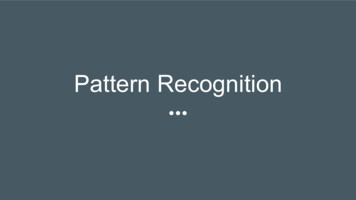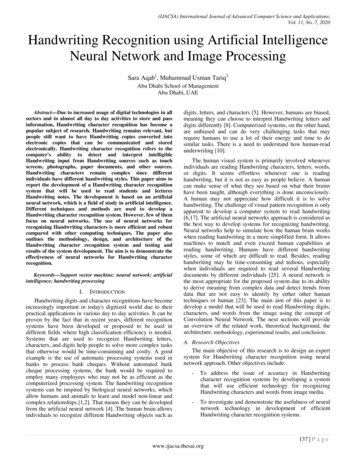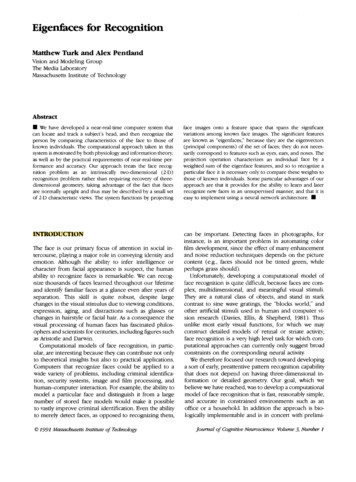
Transcription
Eigenfaces for RecognitionMatthew Turk and Alex PentlandVision and Modeling GroupThe Media LaboratoryMassachusetts Institute of TechnologyAbstract We have developed a near-real-time computer system thatcan locate and track a subject's head, and then recognize theperson by comparing characteristics of the face to those ofknown individuals. The computational approach taken in thissystem is motivated by both physiology and information theory,as well as by the practical requirements of near-real-time per formance and accuracy. Our approach treats the face recog nition problem as an intrinsically two-dimensional (2-D)recognition problem rather than requiring recovery of three dimensional geometry, taking advantage of the fact that facesare normally upright and thus may be described by a small setof 2-D characteristic views. The system functions by projectingface images onto a feature space that spans the significantvariations among known face images. The significant featuresare known as "eigenfaces," because they are the eigenvectors(principal components) of the set of faces; they do not neces sarily correspond to features such as eyes, ears, and noses. Theprojection operation characterizes an individual face by aweighted sum of the eigenface features, and so to recognize aparticular face it is necessary only to compare these weights tothose of known individuals. Some particular advantages of ourapproach are that it provides for the ability to learn and laterrecognize new faces in an unsupervised manner, and that it iseasy to implement using a neural network 'architecture. INTRODUCTIONcan be important. Detecting faces in photographs, forinstance, is an important problem in automating colorfilm development, since the effect of many enhancementand noise reduction techniques depends on the picturecontent (e.g., faces should not be tinted green, whileperhaps grass should).Unfortunately, developing a computational model offace recognition is quite difficult, because faces are com plex, multidimensional, and meaningful visual stimuli.They are a natural class of objects, and stand in starkcontrast to sine wave gratings, the "blocks world," andother artificial stimuli used in human and computer vi sion research (Davies, Ellis, & Shepherd, 1981). Thusunlike most early visual functions, for which we mayconstruct detailed models of retinal or striate activity,face recognition is a very high level task for which com putational approaches can currently only suggest broadconstraints on the corresponding neural activity.We therefore focused our research toward developinga sort of early, preattentive pattern recognition capabilitythat does not depend on having three-dimensional in formation or detailed geometry. Our goal, which webelieve we have reached, was to develop a computationalmodel of face recognition that is fast, reasonably simple,and accurate in constrained environments such as anoffice or a household. In addition the approach is bio logically implementable and is in concert with prelimi-The face is our primary focus of attention in social in tercourse, playing a major role in conveying identity andemotion. Although the ability to infer intelligence orcharacter from facial appearance is suspect, the humanability to recognize faces is remarkable. We can recog nize thousands of faces learned throughout our lifetimeand identify familiar faces at a glance even after years ofseparation. This skill is quite robust, despite largechanges in the visual stimulus due to viewing conditions,expression, aging, and distractions such as glasses orchanges in hairstyle or facial hair. As a consequence thevisual processing of human faces has fascinated philos ophers and scientists for centuries, including figures suchas Aristotle and Darwin.Computational models of face recognition, in partic ular, are interesting because they can contribute not onlyto theoretical insights but also to practical applications.Computers that recognize faces could be applied to awide variety of problems, including criminal identifica tion, security systems, image and film processing, andhuman-computer interaction. For example, the ability tomodel a particular face and distinguish it from a largenumber of stored face models would make it possibleto vastly improve criminal identification. Even the abilityto merely detect faces, as opposed to recognizing them, 1991 Massachusetts Institute of TechnologyJournal of Cognitive Neuroscience Volume 3, Number 1
nary findings in the physiology and psychology of facerecognition.The scheme is based on an information theory approach that decomposes face images into a small set ofcharacteristic feature images called “eigenfaces,” whichmay be thought of as the principal components of theinitial training set of face images. Recognition is performed by projecting a new image into the subspacespanned by the eigenfaces (“face space”) and then classifying the face by comparing its position in face spacewith the positions of known individuals.Automatically learning and later recognizing new facesis practical within this framework. Recognition underwidely varying conditions is achieved by training on alimited number of characteristic views (e.g., a “straighton” view, a 45” view, and a profile view). The approachhas advantages over other face recognition schemes inits speed and simplicity, learning capacity, and insensitivity to small or gradual changes in the face image.Background and Related WorkMuch of the work in computer recognition of faces hasfocused on detecting individual features such as the eyes,nose, mouth, and head outline, and defining a face modelby the position, size, and relationships among these features. Such approaches have proven difficult to extendto multiple views, and have often been quite fragile,requiring a good initial guess to guide them. Researchin human strategies of face recognition, moreover, hasshown that individual features and their immediate relationships comprise an insufficient representation to account for the performance of adult human faceidentification (Carey & Diamond, 1977). Nonetheless,this approach to face recognition remains the most popular one in the computer vision literature.Bledsoe (1966a,b) was the first to attempt semiautomated face recognition with a hybrid human-computersystem that classified faces on the basis of fiducial marksentered on photographs by hand. Parameters for theclassification were normalized distances and ratiosamong points such as eye corners, mouth corners, nosetip, and chin point. Later work at Bell Labs (Goldstein,Harmon, & Lesk, 1971; Harmon, 1971) developed a vector of up to 21 features, and recognized faces usingstandard pattern classification techniques. The chosenfeatures were largely subjective evaluations (e.g., shadeof hair, length of ears, lip thickness) made by humansubjects, each of which would be quite difficult toautomate.An early paper by Fischler and Elschlager (1973) attempted to measure similar features automatically. Theydescribed a linear embedding algorithm that used localfeature template matching and a global measure of fit tofind and measure facial features. This template matchingapproach has been continued and improved by the recent work of Yuille, Cohen, and Hallinan (1989) (see72Journal of Cognitive NeuroscienceYuille, this volume). Their strategy is based on “deformable templates,” which are parameterized models of theface and its features in which the parameter values aredetermined by interactions with the image.Connectionist approaches to face identification seek tocapture the configurational, or gestalt-like nature of thetask. Kohonen (1989) and Kohonen and Lahtio (1981)describe an associative network with a simple learningalgorithm that can recognize (classify) face images andrecall a face image from an incomplete or noisy versioninput to the network. Fleming and Cottrell(l990) extendthese ideas using nonlinear units, training the system bybackpropagation. Stonham’s WSARD system (1986) is ageneral-purpose pattern recognition device based onneural net principles. It has been applied with somesuccess to binary face images, recognizing both identityand expression. Most connectionist systems dealing withfaces (see also Midorikawa, 1988; O’Toole, Millward, &Anderson, 1988) treat the input image as a general 2-Dpattern, and can make no explicit use of the configurational properties of a face. Moreover, some of thesesystems require an inordinate number of training examples to achieve a reasonable level of performance.Only very simple systems have been explored to date,and it is unclear how they will scale to larger problems.Others have approached automated face recognitionby characterizing a face by a set of geometric parametersand performing pattern recognition based on the parameters (e.g., Kaya & Kobayashi, 1972; Cannon, Jones,Campbell, & Morgan, 1986; Craw, Ellis, & Lishman, 1987;Wong, Law, & Tsaug, 1989). Kanade’s (1973) face identification system was the first (and still one of the few)systems in which all steps of the recognition processwere automated, using a top-down control strategy directed by a generic model of expected feature characteristics. His system calculated a set of facial parametersfrom a single face image and used a pattern classificationtechnique to match the face from a known set, a purelystatistical approach depending primarily on local histogram analysis and absolute gray-scale values.Recent work by Burt (1988a,b) uses a “smart sensing”approach based on multiresolution template matching.This coarse-to-fine strategy uses a special-purpose computer built to calculate multiresolution pyramid imagesquickly, and has been demonstrated identifying peoplein near-real-time. This system works well under limitedcircumstances, but should suffer from the typical problems of correlation-based matching, including sensitivityto image size and noise. The face models are built byhand from face images.THE EIGENFACE APPROACHMuch of the previous work on automated face recognition has ignored the issue of just what aspects of the facestimulus are important for identification. This suggestedto us that an information theory approach of coding andVolume 3, Number 1
decoding face images may give insight into the information content of face images, emphasizing the significant local and global “features.” Such features may ormay not be directly related to our intuitive notion of facefeatures such as the eyes, nose, lips, and hair. This mayhave important implications for the use of identificationtools such as Identikit and Photofit (Bruce, 1988).In the language of information theory, we want toextract the relevant information in a face image, encodeit as efficiently as possible, and compare one face encoding with a database of models encoded similarly.A simpleapproach to extracting the information contained in animage of a face is to somehow capture the variation in acollection of face images, independent of any judgmentof features, and use this information to encode and compare individual face images.In mathematical terms, we wish to find the principalcomponents of the distribution of faces, or the eigenvectors of the covariance matrix of the set of face images,treating an image as a point (or vector) in a very highdimensional space. The eigenvectors are ordered, eachone accounting for a different amount of the variationamong the face images.These eigenvectors can be thought of as a set of features that together characterize the variation betweenface images. Each image location contributes more orless to each eigenvector, so that we can display the eigenvector as a sort of ghostly face which we call aneigenface. Some of the faces we studied are illustratedin Figure 1, and the corresponding eigenfaces are shownin Figure 2. Each eigenface deviates from uniform graywhere some facial feature differs among the set of training faces; they are a sort of map of the variations betweenfaces.Each individual face can be represented exactly interms of a linear combination of the eigenfaces. Eachface can also be approximated using only the “best”eigenfaces-those that have the largest eigenvalues, andwhich therefore account for the most variance withinthe set of face images. The best M eigenfaces span anM-dimensional subspace-“face space”-of all possibleimages.The idea of using eigenfaces was motivated by a technique developed by Sirovich and Kirby (1987) and Kirbyand Sirovich (1990) for efficiently representing picturesof faces using principal component analysis. Starting withan ensemble of original face images, they calculated abest coordinate system for image compression, whereeach coordinate is actually an image that they termed aneigenpicture. They argued that, at least in principle, anycollection of face images can be approximately reconstructed by storing a small collection of weights for eachface and's small set of standard pictures (the eigenpictures). The weights describing each face are found byprojecting the face image onto each eigenpicture.It occurred to us that if a multitude of face images canbe reconstructed by weighted sums of a small collectionof characteristic features or eigenpictures, perhaps anefficient way to learn and recognize faces would be tobuild up the characteristic features by experience overtime and recognize particular faces by comparing thefeature weights needed to (approximately) reconstructthem with the weights associated with known individuals.Each individual, therefore, would be characterized bythe small set of feature or eigenpicture weights neededto describe and reconstruct them-an extremely compact representation when compared with the imagesthemselves.This approach to face recognition involves the following initialization operations:1. Acquire an initial set of face images (the trainingset).2. Calculate the eigenfaces from the training set, keeping only the M images that correspond to the highesteigenvalues. These M images define the face space. Asnew faces are experienced, the eigenfaces can be updated or recalculated.3. Calculate the corresponding distribution in M-dimensional weight space for each known individual, byprojecting their face images onto the “face space.”These operations can also be performed from timeto time whenever there is free excess computationalcapacity.Having initialized the system, the following steps arethen used to recognize new face images:1. Calculate a set of weights based on the input imageand the M eigenfaces by projecting the input image ontoeach of the eigenfaces.2. Determine if the image is a face at all (whetherknown or unknown) by checking to see if the image issufficiently close to “face space.”3. If it is a face, classify the weight pattern as either aknown person or as unknown.4. (Optional) Update the eigenfaces and/or weightpatterns.5. (Optional) If the same unknown face is seen severaltimes, calculate its characteristic weight pattern and incorporate into the known faces.Calculating EigenfacesLet a face image Z(x,y) be a two-dimensional N by N arrayof (8-bit) intensity values. An image may also be considered as a vector of dimension N2, so that a typical imageof size 256 by 256 becomes a vector of dimension 65,536,or, equivalently, a point in 65,536-dimensional space. Anensemble of images, then, maps to a collection of pointsin this huge space.Images of faces, being similar in overall configuration,will not be randomly distributed in this huge image spaceand thus can be described by a relatively low dimensional subspace. The main idea of the principal compoTurk and Pentland73
Figure 1. (a)Face imagesused as the training set.nent analysis (or Karhunen-Loeve expansion) is to findthe vectors that best account for the distribution of faceimages within the entire image space. These vectors define the subspace of face images, which we call “facespace.” Each vector is of length N‘, describes an N by Nimage, and is a linear combination of the original faceimages. Because these vectors are the eigenvectors ofthe covariance matrix corresponding to the original faceimages, and because they are face-like in appearance, werefer to them as “eigenfaces.” Some examples of eigenfaces are shown in Figure 2 .Let the training set of face images be rl,r2,r3,. . . ,r,,, The average face of the set is defined by Z: : , r,. Each face differs from the average by the I?, - W ,An example training set is shownvectorin Figure la, with the average faceshown in Figurel b . This set of very large vectors is then subject to principal component analysis, which seeks a set of M orthonormal vectors, un,which best describes the distributionof the data. The kth vector, u k , is chosen such that*Ak l M(Uz@n)2M n 1-is a maximum, subject to74Journal of Cognitive Neuroscience(1)The vectors w and scalars Xk are the eigenvectors andeigenvalues, respectively, of the covariance matrix1c Mcn A (3)Twhere the matrix A [alcP2 . . . @MI. The matrix C,however, is N’ by N’, and determining the N’ eigenvectors and eigenvalues is an intractable task for typicalimage sizes. Me need a computationally feasible methodto find these eigenvectors.If the number of data points in the image space is lessthan the dimension of the space ( M N’), there will beonly M - 1, rather than N2, meaningful eigenvectors.(The remaining eigenvectors will have associated eigenvalues of zero.) Fortunately we can solve for the N2dimensional eigenvectors in this case by first solving forthe eigenvectors of an M by M matrix--e.g., solving a16 X 16 matrix rather than a 16,384 X 16,384 matrixVolume 3, Number 1
Following this analysis, we construct the M by M matrixL ATA, where L,, and find the M eigenvectors, VL,of L . These vectors determine linear combinations of the M training set face images to form theeigenfaces UI.MUl xv[k@k,k 1t! 1 , . . . ,M(6)With this analysis the calculations are greatly reduced,from the order of the number of pixels in the images( N 2 )to the order of the number of images in the trainingset (M). In practice, the training set of face images willbe relatively small (M G N’), and the calculations becomequite manageable. The associated eigenvalues allow usto rank the eigenvectors according to their usefulness incharacterizing the variation among the images. Figure 2shows the top seven eigenfaces derived from the inputimages of Figure 1.Figure 1. (b) The average faceUsing Eigenfaces to Classify a Face Imagew.Figure 2. Seven of the eigenfaces calculated from the input imagesof Figure 1.and then taking appropriate linear combinations of theface imagesConsider the eigenvectors vrof ATA suchthatA A V , F,V,(4)Premultiplying both sides by A, we haveAArAvl pAv1(5)from which we see that Av, are the eigenvectors of CAAT. The eigenface images calculated from the eigenvectorsof L span a basis set with which to describe face images.Sirovich and Kirby (1987) evaluated a limited version ofthis framework on an ensemble of M 115 images ofCaucasian males, digitized in a controlled manner, andfound that about 40 eigenfaces were sufficient for a verygood description of the set of face images. With M‘ 40 eigenfaces, RMS pixel-by-pixel errors in representingcropped versions of face images were about 2%.Since the eigenfaces seem adequate for describing faceimages under very controlled conditions, we decided toinvestigate their usefulness as a tool for face identification. In practice, a smaller M’ is sufficient for identification, since accurate reconstruction of the image is not arequirement. In this framework, identification becomesa pattern recognition task. The eigenfaces span an M’dimensional subspace of the original N’ image space.The M’ significant eigenvectors of the L matrix are chosenas those with the largest associated eigenvalues. In manyof our test cases, based o n M 16 face images, M’ 7eigenfaces were used.A new face image (I?) is transformed into its eigenfacecomponents (projected into “face space”) by a simpleoperation,wk U,’ r- q )(7)for k 1, . . . , M’. This describes a set of point-by-pointimage multiplications and summations, operations performed at approximately frame rate on current imageprocessing hardware. Figure 3 shows an image and itsprojection into the seven-dimensional face space.The weights form a vector RT [w,, 0 2 . . . wM8]thatdescribes the contribution of each eigenface in representing the input face image, treating the eigenfaces as abasis set for face images. The vector may then be usedTurk and Pentland75
in a standard pattern recognition algorithm to find whichof a number of predefined face classes, if any, best describes the face. The simplest method for determiningwhich face class provides the best description of an inputface image is to find the face class k that minimizes theEuclidian distancewhere a k is a vector describing the kth face class. Theface classesare calculated by averaging the results ofthe eigenface representation over a small number of faceimages (as few as one) of each individual. A face isclassified as belonging to class k when the minimum Ekis below some chosen threshold 8,. Otherwise the faceis classified as “unknown,” and optionally used to createa new face class.Because creating the vector of weights is equivalent toprojecting the original face image onto the low-dimensional face space, many images (most of them lookingnothing like a face) will project onto a given patternvector. This is not a problem for the system, however,since the distance E between the image and the facespace is simply the squared distance between the meanadjusted input image Q, r - 1Ir and Q,f Ct21 w2u2,its projection onto face space:a,with the highest associated eigenvalues. (Let M’ 10 inthis example.)3. Combine the normalized training set of images according to Eq. (6) to produce the (M’ 10) eigenfacesuk.4. For each known individual, calculate the class vectorby averaging the eigenface pattern vectors IR [fromEq. (S)] calculated from the original (four) images of theindividual. Choose a threshold 8, that defines the maximum allowable distance from any face class, and athreshold 8, that defines the maximum allowable distance from face space [according to Eq. (9)].5. For each new face image to be identified, calculateits pattern vector 0,the distances to each known class,and the distance E to face space. If the minimum distanceEk 8, and the distance E 8,, classify the input faceas the individual associated with class vector &. If theminimum distance Ek 8, but distance E 8,, then theimage may be classifed as “unknown,” and optionallyused to begin a new face class.6. If the new image is classified as a known individual,this image may be added to the original set of familiarface images, and the eigenfaces may be recalculated(steps 1-4). This gives the opportunity to modify the facespace as the system encounters more instances of knownfaces.Summary of Eigenface RecognitionProcedureIn our current system calculation of the eigenfaces isdone offline as part of the training. The recognitioncurrently takes about 400 msec running rather inefficiently in Lisp on a Sun4, using face images of size 128 X128. With some special-purpose hardware, the currentversion could run at close to frame rate (33 msec).Designing a practical system for face recognitionwithin this framework requires assessing the tradeoffsbetween generality, required accuracy, and speed. If theface recognition task is restricted to a small set of people(such as the members of a family or a small company),a small set of eigenfaces is adequate to span the faces ofinterest. If the system is to learn new faces or representmany people, a larger basis set of eigenfaces will berequired. The results of Sirovich and Kirby (1987) andKirby and Sirovich (1990) for coding of face images givessome evidence that even if it were necessary to representa large segment of the population, the number of eigenfaces needed would still be relatively small.To summarize, the eigenfaces approach to face recognition involves the following steps:Locating and Detecting Faces1. Collect a set of characteristic face images of theknown individuals. This set should include a number ofimages for each person, with some variation in expression and in the lighting. (Say four images of ten people,so M 40.)2 . Calculate the (40 X 40) matrix L , find its eigenvectors and eigenvalues, and choose the M‘ eigenvectorsThe analysis in the preceding sections assumes we havea centered face image, the same size as the trainingimages and the eigenfaces. We need some way, then, tolocate a face in a scene to do the recognition. We havedeveloped two schemes to locate and/or track faces, using motion detection and manipulation of the images in“face space”.Thus there are four possibilities for an input image andits pattern vector: (1) near face space and near a faceclass, ( 2 ) near face space but not near a known face class,(3) distant from face space and near a face class, and (4)distant from face space and not near a known face class.In the first case, an individual is recognized and identified. In the second case, an unknown individual is present. The last two cases indicate that the image is not aface image. Case three typically shows up as a false positive in most recognition systems; in our framework,however, the false recognition may be detected becauseof the significant distance between the image and thesubspace of expected face images. Figure 4 shows someimages and their projections into face space and gives ameasure of distance from the face space for each.76Journal of Cognitive NeuroscienceVolume 3, Number I
IFigure 3. An original face image and its projection onto the face space defined by the eigenfaces of Figure 2.Motion Detecting a n d Head TrackingPeople are constantly moving. Even while sitting, wefidget and adjust our body position, nod our heads, lookaround, and such. In the case of a single person movingin a static environment, a simple motion detection andtracking algorithm, depicted in Figure 5, will locate andtrack the position of the head. Simple spatiotemporalfiltering (e.g., frame differencing) accentuates image locations that change with time, so a moving person “hghtsup” in the filtered image. If the image “lights up” at all,motion is detected and the presence of a person ispostulated.After thresholding the filtered image to produce abinary motion image, we analyze the “motion blobs” overtime to decide if the motion is caused by a personmoving and to determine head position. A few simplerules are applied, such as “the head is the small upperblob above a larger blob (the body),” and “head motionmust be reasonably slow and contiguous” (heads are notexpected to jump around the image erratically). Figure6 shows an image with the head located, along with thepath of the head in the preceding sequence of frames.The motion image also allows for an estimate of scale.The size of the blob that is assumed to be the movinghead determines the size of the subimage to send to therecognition stage. This subimage is rescaled to fit thedimensions of the eigenfaces.Using ‘FaceSpace” to Locate the FaceWe can also use knowledge of the face space to locatefaces in single images, either as an alternative to locatingfaces from motion (e.g., if there is too little motion ormany moving objects) or as a method of achieving moreprecision than is possible by use of motion trackingalone. This method allows us to recognize the presenceof faces apart from the task of identifying them.As seen in Figure 4, images of faces do not changeradically when projected into the face space, while theprojection of nonface images appears quite different.This basic idea is used to detect the presence of faces ina scene: at every location in the image, calculate thedistance E between the local subimage and face space.This distance from face space is used as a measure of“faceness,”so the result of calculating the distance fromface space at every point in the image is a “face map”E ( J ) . Figure 7 shows an image and its face map-lowvalues (the dark area) indicate the presence of a face.Unfortunately, direct application of Eq. (9) is ratherexpensive. We have therefore developed a simpler, moreefficient method of calculating the face map E ( x , ) , whichis described as follows.To calculate the face map at every pixel of an imageZ(x,y), we need to project the subimage centered at thatpixel onto face space, then subtract the projection fromthe original. To project a subimage r onto face space,we must first subtract the mean image, resulting in Q, r - W.With @f being the projection of CD onto facespace, the distance measure at a given image location isthenE2 /I@ - @#(a- WQ, VQ, -- @f)@;a, a (@-(10)@f)Turk and Pentland77
Figure 4 . Three images andtheir projections onto the facespace defined by the eigenfaces of Figure 2. The relativemeasures of distance from faceSpace are (a) 29.8, (b) 58.5,( c ) 5217.4. Images (a) and (b)are in the original training set.since Qf i (@ - af).Because @f is a linear combinationof the eigenfaces (@f C: , omi)and the eigenfacesare orthonormal vectors,andwhere E ( x , ) and oi(x,y) are scalar functions of imagelocation, and @(x,y) is a vector function of image location.The second term of Eq. (12) is calculated in practiceby a correlation with the L eigenfaces:78Journal of Cognitiije NeuroscienceVolume 3, Number 1
Figure 5. The head tracking and locating systemworks, these computations can be implemented by asimple neural network.Learning to Recognize New FacesFigure 6. The head has been located-the image in the box is sentto the face recognition process. Also shown is the path of the headtracked over several previous frames.The concept of face space allows the ability to learn andsubsequently recognize new faces in an unsupervisedmanner. When an image is sufficiently close to face spacebut is not classified as one of the
face recognition is a very high level task for which com putational approaches can currently only suggest broad constraints on the corresponding neural activity. We therefore focused our research toward developing a sort of early, preattentive pattern recognition capabi



